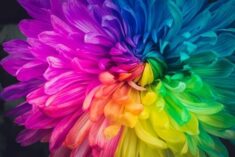
Human beings prefer our lives to be colorful – literally. As The Ultimate Guide to Using Color Psychology in Marketing says:
“Color is an essential tool because it has an impact on how we think and behave. Color directs our eye where to look, what to do, and how to interpret something. It puts content into context. It helps us decide what’s important and what’s not.”
Understanding how we react to color is, not surprisingly, critical to design. But it may interest you to learn that there appears to be an evolutionary component to our color preferences, which is even more compelling when it comes to how color affects our buying decisions.

First, one general note about our biology: we are visual beings. “Your brain is really one big organ for making sense of the world, and it does that almost entirely through vision. Yes, we smell, taste, touch, hear and such . . . but seeing is our primary sense, by a long distance. About 20% of your brain is there purely for vision,” says neuroscientist Andrew Tate .
When it comes to visual design, infographic creators Venngage reinforce that point. “People are visually oriented: 90% of information transmitted to our brain is visual, presentations with visuals are 43% more persuasive, and 65% of us are visual learners. In fact, 93% of all communication is nonverbal. Visuals attract our attention, enhance our emotions, and affect our attitude.”
Along with movement , color is a key element of what attracts us visually. And as is true with the way we react to motion, evolution also may play a role in our color preferences. Tate cites a 2010 study from the University of California at Berkeley that looked at our color likes and dislikes. Back when we started to evolve, for example, browns and yellows were colors we wanted to avoid when foraging for food, as they indicated spoilage.
Today, when people are surveyed about the colors they like, brown and yellow aren’t high on the list, so we still may have an unconscious bias towards them – a holdover from our earliest days. However, Tate says, “Because our brains are starting to catch up with the fact that we do not have to go out looking for food anymore, this phenomenon is starting to shift so that we can think that good colors are ones that we have a personal preference for, even if that is brown.
Along those lines, when it comes to color, interpretations are somewhat subjective. They vary from one culture to another, though are largely consistent within them. For example, western minds such as ours most likely would interpret the following four common colors as follows, according to one source :
- Red: powerful, dynamic, passionate.
- Orange: energizing, friendly, fun.
- Green: balanced, peaceful, healthy.
- Blue: reliable, trustworthy, soothing.
However, red also can signal danger and anger to us, and blue can seem cold and unfriendly when overused. The trick is understanding the potential connotations of color and using it wisely. For example, red might be an accent, rather than the main color, in a design if the creator wants to avoid it being perceived in a negative way.
Color interpretations also can be influenced by personal experience, both positive and negative. “The conclusion is that color preferences derive from our preference for the objects that typically have these colors,” says a Psychology Today blog about the same Berkeley research Tate references. “Everyone has a somewhat different life experience, and so as people increasingly experience pleasure in something they bought in a particular color, they will tend to choose similar objects in the future with the same color.”
In other words, if you love green apples and your favorite shirt is green, you’ll be drawn to the color green in general and are more likely to paint a wall that color.
Why is understanding color preferences (and other elements of color theory we haven’t mentioned here) critical to marketers of all types? Because of the enormous impact color has on what we’re attracted to and what we buy.
Almost 93 percent of people say that the visual dimension is the most influential factor in a purchasing decision. “Studies suggest that people make a subconscious judgment about a product within 90 seconds of initial viewing [and] . . . up to 90% of that assessment is based on color alone,” this guide to customer psychology explains.
Of course, in our work, we’re most often presented with brand standards that dictate the colors we use. However, there’s usually room for creative choices that fall within the guidelines, and we can apply our knowledge of color and color preferences to our digital signage designs. But the importance of color to consumers means that marketers need more than a working knowledge of color theory. Many could benefit from taking a deeper dive into the topic to make better choices about logo designs and product colors. Your bottom line might depend on it.
The post The Color Connection appeared first on Blog by Convergent .

